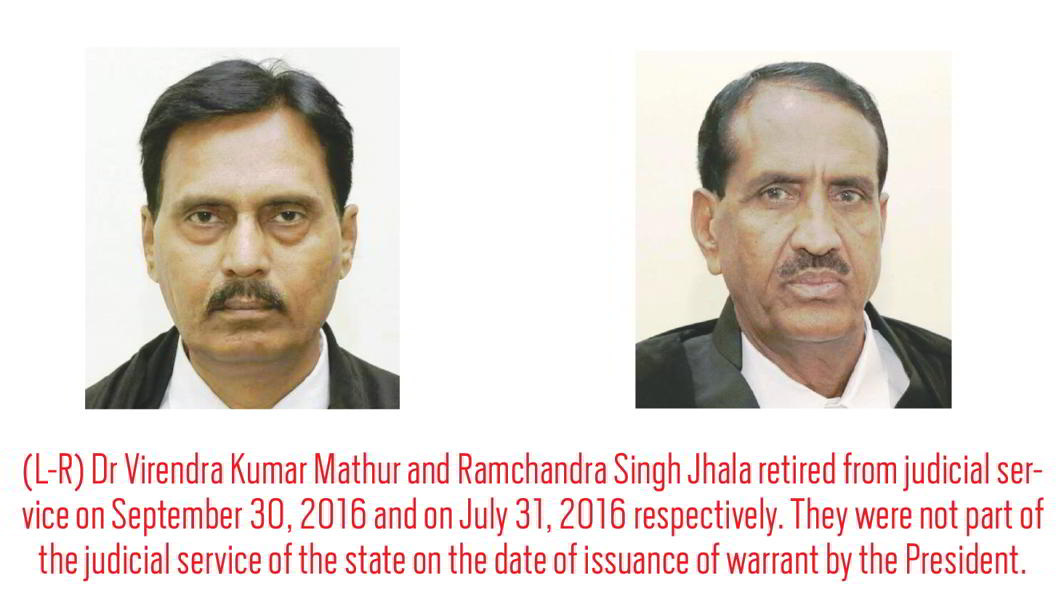Above: Rajasthan High Court
In a rare case, the apex court issued notices to two Rajasthan High Court judges who retired in 2016 and were ineligible for the post of additional judges
~By Vinay Vats
In a one-of-its-kind move, the Supreme Court has issued notices on a petition challenging the appointment of two additional judges in the Rajasthan High Court. A bench headed by Justices AK Sikri and Ashok Bhushan issued the notices to Dr Virendra Kumar Mathur and Ramchandra Singh Jhala challenging their appointments as additional judges of the High Court.
On May 12, 2017, the government had published a notification in the Official Gazette that in exercise of the powers conferred by Clause (1) of Article 224 of the Constitution, the president is pleased to appoint Ashok Kumar Gaur, Manoj Kumar Garg, Inderjeet Singh, Dr Virendra Kumar Mathur and Ramchandra Singh Jhala as additional judges of the Rajasthan High Court in order of seniority.
The appointment of Ashok Kumar Gaur, Manoj Kumar Garg and Inderjeet Singh was for a period of two years with effect from the date they assumed charge of their respective offices. However, the period of appointment of Dr Virendra Kumar Mathur and Ramchandra Singh Jhala was with effect from the date they assumed charge of their respective offices till September 1, 2018 and July 2, 2018 respectively.
The petition contends that the law declared by a constitutional bench of the Supreme Court in the case of SP Gupta and Others Vs Union of India and Others [(1981) Supp SCC 87], mandates a minimum term of two years for an additional judge, appointed under Article 224 (1) of the constitution in a high court where judicial arrears (pending cases) are of more than two years.
Thus, it is alleged that the appointments of Virendra Kumar Mathur and Ramchandra Singh Jhala for a short period of 1 year, 3 months, 17 days and 1 year, 1 month, 17 days respectively in Rajasthan High Court, where arrears of pending cases is more than 10 years, is contrary to the minimum term prescribed by the constitutional bench judgment and is therefore void from the beginning.
The petition also says that the present appointments are also contrary to Article 217(2)(a) in view of the law declared by the Supreme Court in Kumar Padma Prasad Vs Union of India and Others [AIR 1992 SC 1213]. There it was categorically declared that in order to qualify for appointment as a judge of a high court under Article 217 (2) (a), a person “must hold” “judicial office” which must be a part of judicial service of the state and that qualification for appointment has to be seen on the date of issuance of warrant by the President of India.
What the law says
This is what the constitution says on the appointment of additional and acting judges:
Article 224
(1) If by reason of any temporary increase in the business of a high court or by reason of arrears of work therein, it appears to the President that the number of the judges should be increased, he may appoint duly qualified persons to be additional judges there for such period not exceeding two years as he may specify.
(2) When any judge of a high court other than the chief justice is by reason of absence or for any other reason unable to perform the duties of his office or is appointed to act temporarily as chief justice, the President may appoint a duly qualified person to act as a judge of that court until the permanent judge has resumed his duties.
(3) No person appointed as an additional or acting judge of a high court shall hold office after attaining the age of 62.
Article 217
Every judge of a high court shall be appointed by the President by warrant under his hand and seal after consultation with the chief justice of India, the governor of the state, and, in the case of appointment of a judge other than the chief justice, the chief justice of the high court, and shall hold office for two years.
Mathur and Jhala retired from judicial service on attaining the superannuation age of 60 years on September 30, 2016 and on July 31, 2016 respectively. Thus, they neither held judicial office nor were part of the judicial service of the state on the date of issuance of warrant by the President of India. Hence, the appointments are bad in law.
In April 2016, the Supreme Court had put on hold the appointments of 110 additional judges till it ratified the long-awaited revised draft of the Memorandum of Procedure. Even at that time, recommendations were made by chief justices of different high courts. In Dec-ember 2015, a constitutional bench of the Supreme Court had directed the government to draft a Memorandum of Procedure for appointment of Supreme Court and High Court judges with some basic guidelines.
One draft was prepared by the government and sent back with some modifications. Since then, it has been pending with then Chief Justice of India Justice TS Thakur and is now with Justice Dipak Misra for final approval.
—The writer is a Supreme Court Advocate


